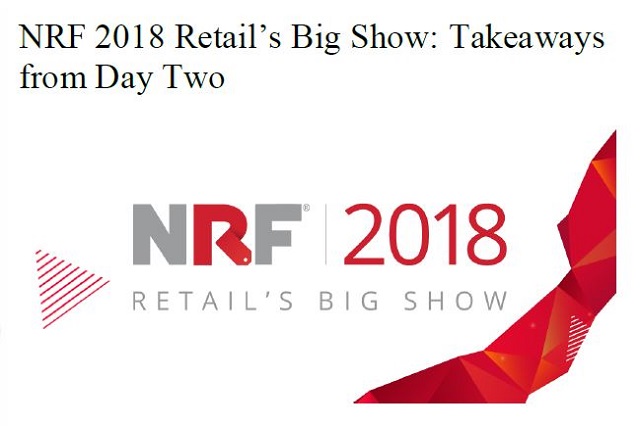1) IBM demonstrated a blockchain application for supply chains and a retail analytics platform called MetroPulse, among other technologies.
IBM’s booth at NRF 2018 Retail’s Big Show included a section titled “IBM Blockchain,” where the company demonstrated a blockchain application for the supply chain. Bitcoin, which is built atop a public, encrypted blockchain, is making headlines these days, but private blockchains can be shared between vendors and customers, enabling certain customers to view selected portions of the blockchain.
One application of the technology is smart contracts, which act like little programs and effect payment when certain conditions are met. These contracts negate the need for staff to spend hours poring over faxes and spreadsheets and talking on the phone to verify compliance. IBM’s blockchain technology is based on the Hyperledger Fabric framework, which is open-source and therefore benefits from the combined efforts of all who download and improve the code.
IBM also demonstrated its MetroPulse analytics system, which integrates weather, demographic and commercial data, as well as information on local events, into retail inventory planning and forecasting. In the demo, the IBM representative was able to combine information about weather and local events (such as sports matches) in order to forecast increases in retail demand. The system was able to calculate how many units of a given product should be stocked versus normal inventory levels, based on the inputs. The platform was also able to manipulate demographic data such as income per capita and the location of competitors’ stores in order to find the optimal location for a new store.
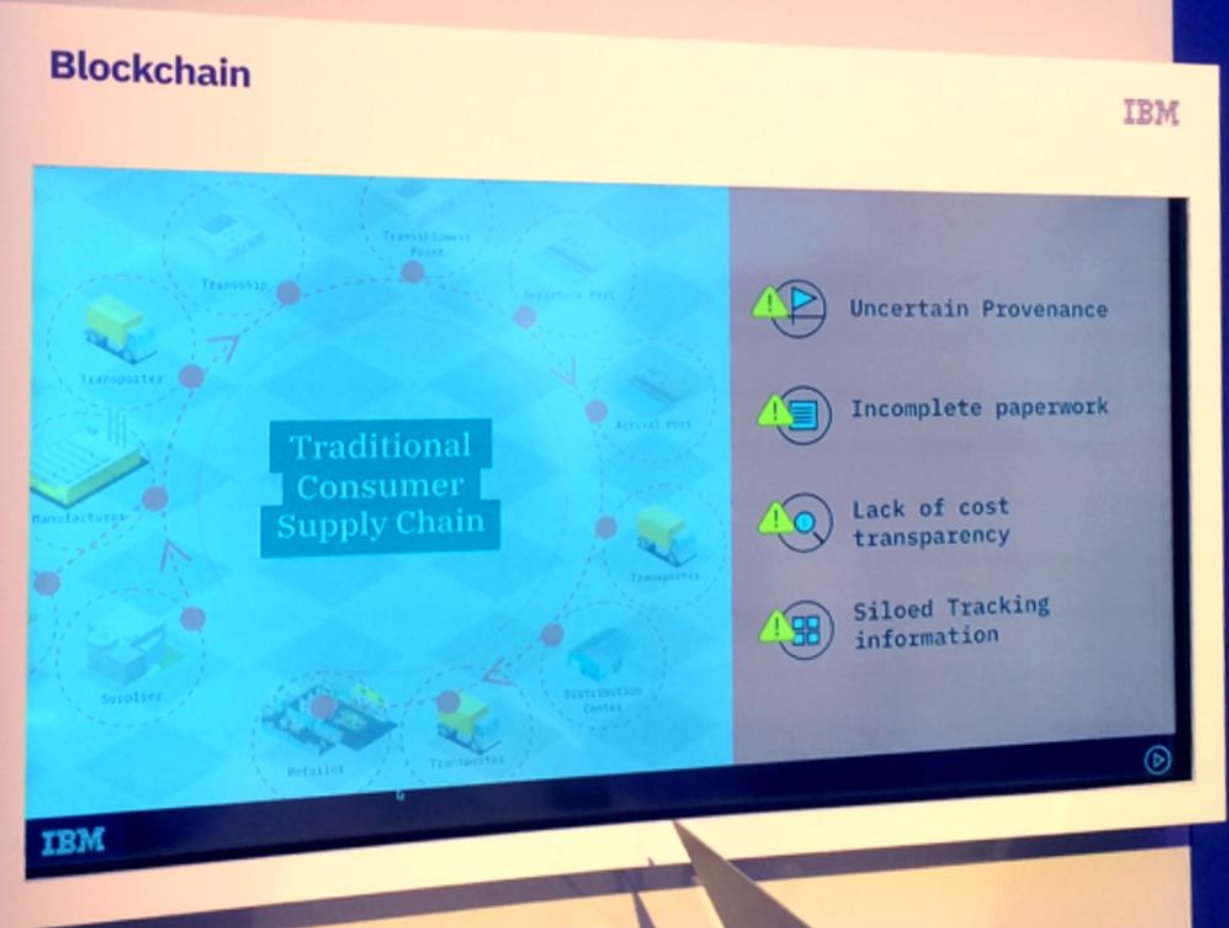
IBM’s blockchain technology demonstration
Source: FGRT
2) Spencer Fung, CEO of Li & Fung, delivered a keynote presentation on creating the retail supply chain of the future.
Spencer Fung, CEO of Li & Fung, delivered a keynote presentation that stressed how urgent it is that retailers digitalize their supply chains and the tangible benefits of doing so. Getting the right products in front of customers improves the chance of a sale and decreases the possibility of a markdown, Fung noted.
Li & Fung is actively seeking partnerships to create a digital supply chain ecosystem that includes brands and retailers, technology providers, virtual design companies, and procurement platforms. The goal is to create an end-to-end, fully digitalized supply chain that can respond to consumer demand immediately and significantly shorten the lead time from concept to store for retailers. Fung said that the company is focused on the product development stage of the process. Digital sampling will allow companies to shorten the typical three-to-six-month product development cycle to a matter of days, he said.
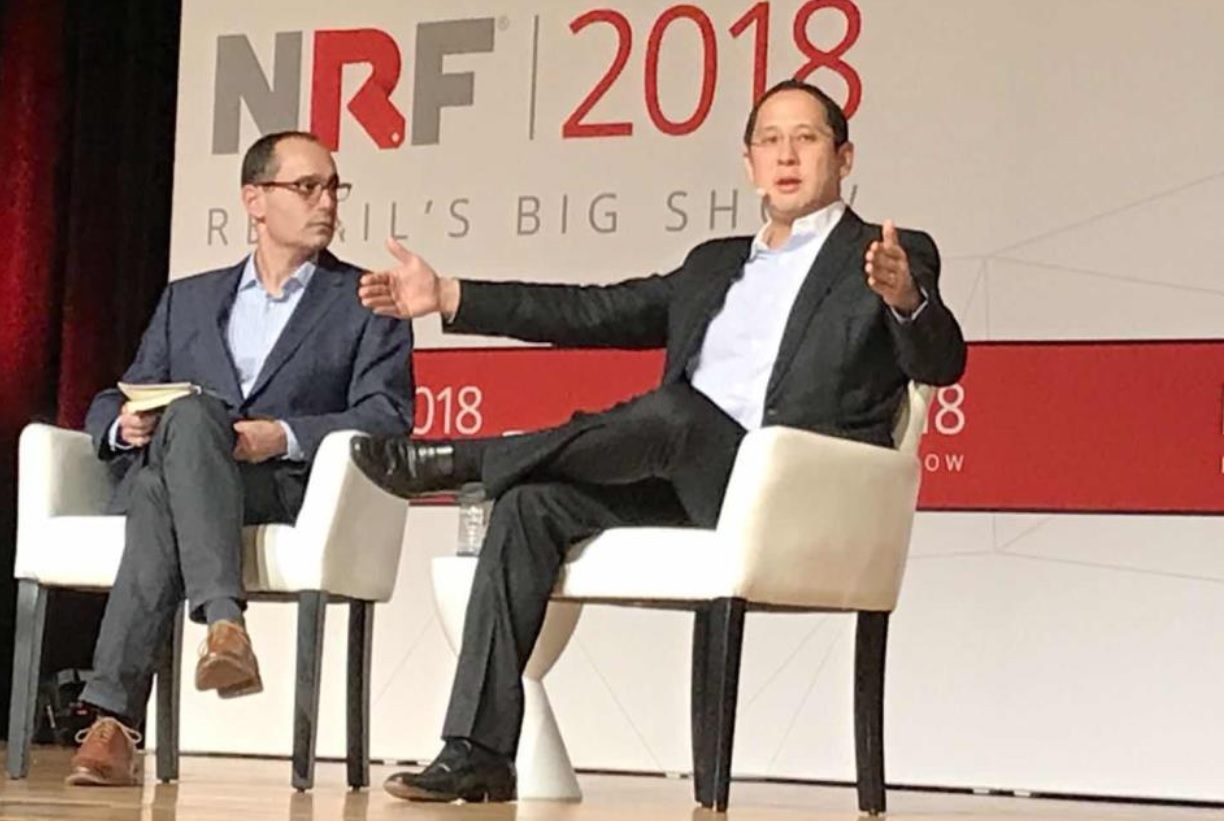
Phil Wahba (left), Senior Writer at Fortune, interviews Spencer Fung, CEO of Li & Fung
Source: FGRT
3) AI is transforming the retail space by helping retailers provide engaging customer experiences and personalized interactions as well as enabling them to deliver products to customers anywhere, at any time.
Deborah Weinswig, Managing Director of FGRT, moderated a session titled “How AI Is Currently Powering Retail’s Growth.” The panel discussed how AI is transforming the retail space, improving business operations and, ultimately, delivering a more engaging customer experience.
Weinswig kicked off the session by discussing the concept of New Retail, a term coined by Alibaba to refer to the next generation of consumer experiences. New Retail involves providing the best customer service, 24/7, no matter where the customer is, and delivering the product to the customer anywhere, at any time. AI helped Alibaba achieve record sales during its 11.11 Global Shopping Festival on Singles’ Day in 2017. The company’s AI-enabled customer service handled 95% of inquiries on Singles’ Day. In 2016, it helped Alibaba record 20% higher conversion rates on personalized landing pages during the 11.11 event compared with nonpersonalized pages, Weinswig said.
Facial recognition is another technology that Weinswig noted will make a major impact in the retail space. Both Alibaba and Tencent are launching facial recognition technologies for payments and verification. Alibaba’s “pay with selfie” technology enables consumers to use facial recognition to make payments at some KFC locations and at public transit systems.
1-800-Flowers.com believes that technologies such as chatbots are making online interactions simpler by providing another way to communicate. Last year, 1-800-Flowers.com launched GWYN, an AI chatbot powered by IBM Watson that learns a customer’s preferences as the customer interacts with the system. The AI-powered “virtual concierge” assists customers in navigating available products and makes suggestions, answers questions and helps customers complete their purchases.
Chris McCann, President and CEO at 1-800-Flowers.com, said that conversational commerce, specifically voice commerce, can recreate one-on-one conversations and personalize interactions. In October, the company launched a new capability that allows customers to use Google Assistant on a mobile phone to place an order via voice or text. “We continue to embrace and invest in technology that makes it easier for gift givers to shop with us, wherever, whenever and however they choose,” said McCann.
Silvia Campello, President and COO at lingerie company Cosabella, discussed the four main platforms in which Cosabella is using AI: advertising, email automation, A/B testing and product recommendations. She said that the company is using A/B testing to test different dimensions, fonts, styling and other aspects of its website design. Cosabella uses an AI-powered algorithm to test alternative options for the website design based on the conversion rate generated by each variant. The optimization of website design through AI resulted in a 30% increase in conversion rate, according to Campello.
Kris Miller, Chief Strategy Officer at eBay, discussed how the customer’s end-to-end journey in commerce is changing. For eBay, which has more than 1 billion product listings, improving its search functionality was critical. The company is using machine learning in search optimization to drive personalization and improve the customer experience. In October, eBay debuted its Grouped Listings feature, which organizes search results by item, rather than displaying each seller’s product listing.
The company also rolled out two visual search features—Find It On eBay and Image Search—for its mobile app. The Find It On eBay feature allows customers to search for products on eBay by sharing images from social media platforms. Image Search enables customers to take pictures, or use existing ones on their phones, to find similar listings on eBay.
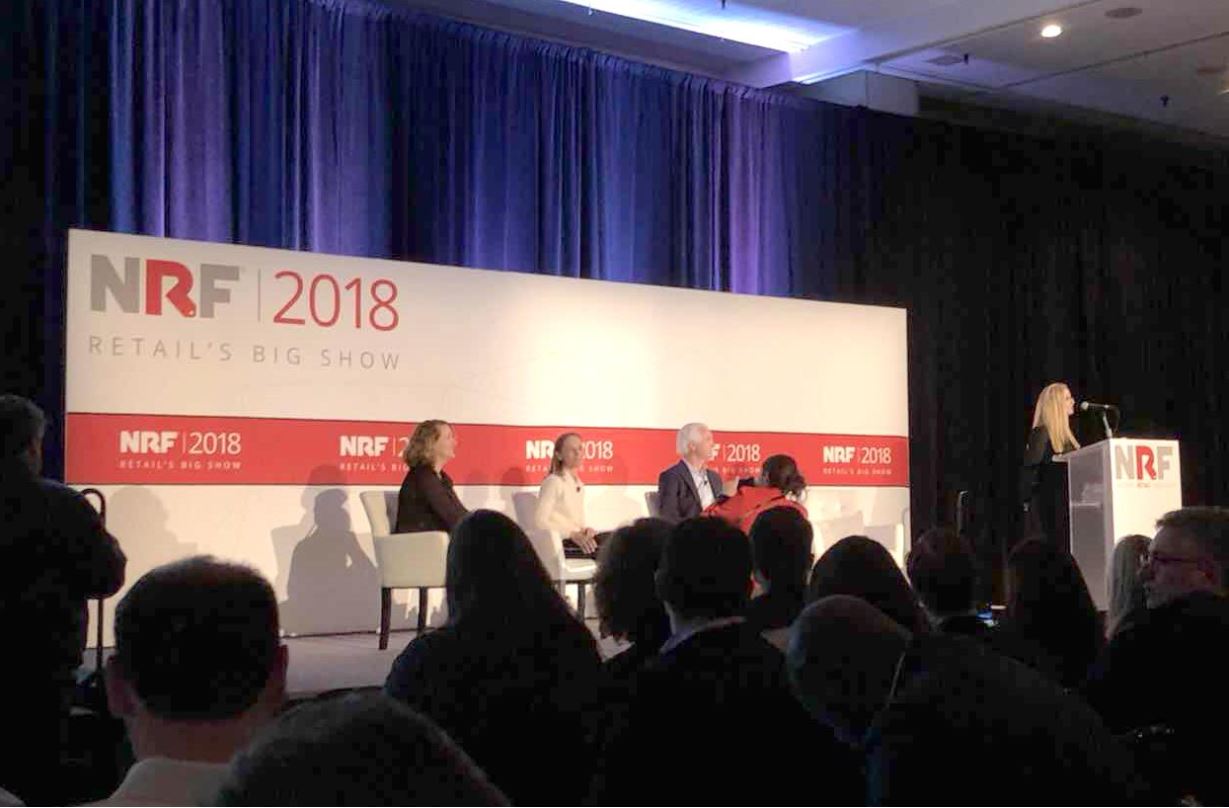
Deborah Weinswig, Managing Director of FGRT, moderates a panel discussion on how AI is transforming retail
Source: FGRT
4) Despite negative events and data, there are many positives with regard to the outlook for retail.
Lee Peterson, EVP of Brand, Strategy and Design at customer experience firm WD Partners, gave a presentation titled “Leading with Positivity: Retail 2018.” He began by sharing a Japanese proverb that translates as “the reverse side has a reverse side”—English speakers might know this concept as “every cloud has a silver lining.” Peterson gave a rundown of the negatives the industry is facing, which are well documented: foot traffic has been falling; 25% of malls are expected to close within the next five years; retailers are reducing headcounts while installing robots; and customers complain that employees are not helpful, dressing rooms are uncomfortable and stores are disorganized. In addition, a recent survey found that just 8% of retailers polled felt that they had successfully implemented omnichannel operations, Peterson said.
There are many bright spots in retail, though. Peterson noted that the NRF had adjusted its retail sales growth estimate upward and that e-commerce is booming. He also said that retailers see a 52% increase in web traffic, on average, within six weeks of opening a physical store. He noted that a recent survey found that consumers favor drive-through pickup, in-store pickup and food service on-site (millennials particularly like the latter). In the consumer survey, the companies that performed best were those that offered great customer service. With the arrival of digital natives, “the consumer is the POS [point of sale],” Peterson said.
He also noted that one giant retailer had recently thrown parties for its employees, raised pay and benefits, offered discounts for in-store pickup, opened training academies, made several key acquisitions, and is now testing cashierless checkout (like at Amazon Go). Peterson said that the retailer recently saw comp increases and a huge increase in e-commerce sales. Finally, he noted that new stores consider metrics such as customer dwell time and total in-store plus online revenue, as opposed to only looking at traditional metrics.
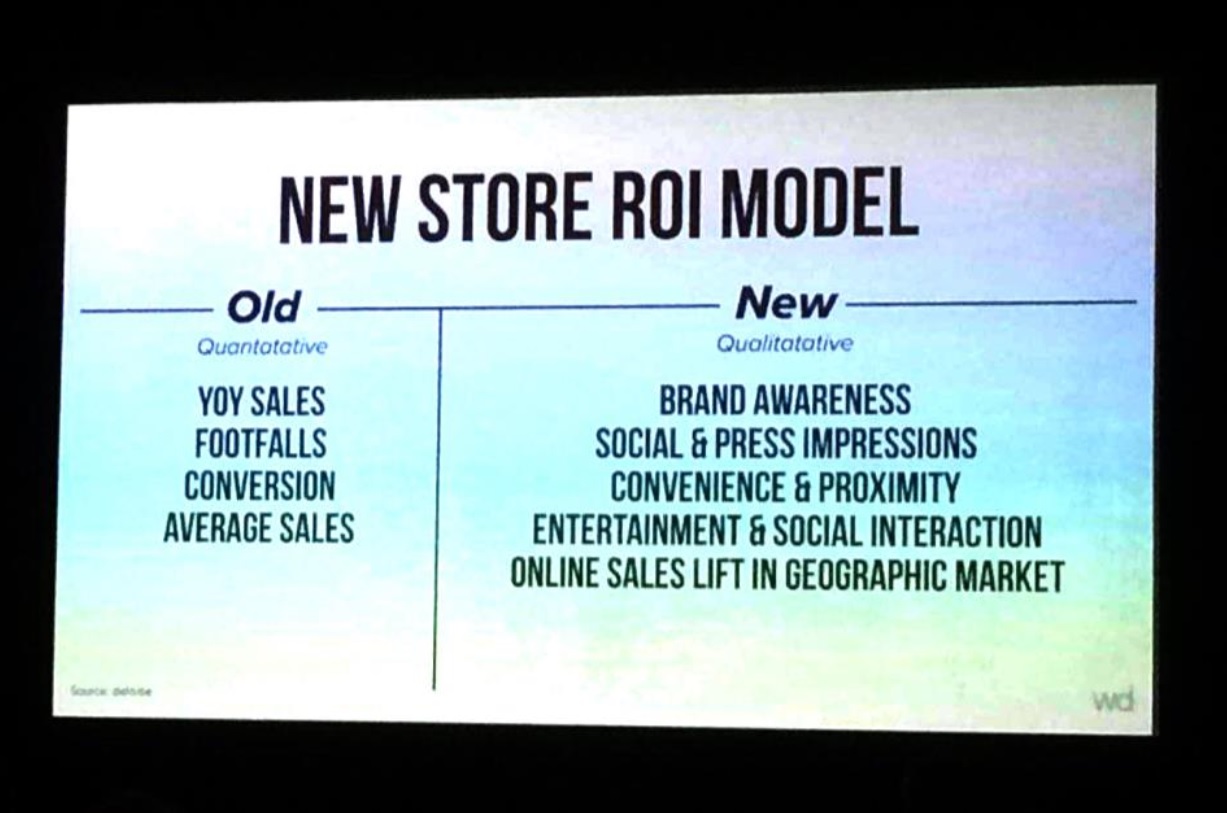
Slide from Lee Peterson’s presentation depicting old versus new store ROI models
Source: FGRT
5) Salesforce showcased AI-powered personalization and engagement.
At the Salesforce booth, the company showcased its cloud commerce capabilities through its partnership with New Balance. At the booth, visitors can experience a virtual tour of a New Balance store that features engaging content such as a video showing how New Balance can build custom-made running shoes for customers. In addition, visitors can see a demo of New Balance’s mobile commerce platform, which is powered by Salesforce. The mobile customer journey on the platform takes the shopper seamlessly between social media and New Balance’s website, which includes AI-driven product recommendations and a product customization tool. Salesforce is betting on creating personalized experiences and interactions for customers while leveraging the Einstein AI engine and its Customer Success data analytics team.
Look for our continued coverage of NRF 2018 Retail’s Big Show tomorrow.
